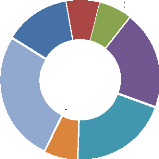3.4 WACC Estimation
Regarding the WACC estimation, 2 types of data will be used:
primary and secondary data. For primary data, we will use:
- Results of the farms from Isère extracted from the
database of the CERFRANCE Isère to calculate the weighted average
leverage by specialization. The time frame of the dataset is 2006-2010, with
620 farms. The characteristics of this dataset are presented in detail in part
3.2.
- Sample collection of 46 recent loan's rate for all
specialization in the database of the
CERFRANCE Isère, to determine the market value of the cost
of debt.
Regarding secondary data, we will use:
- The market capitalization and the beta calculated by Bloomberg
for all the companies listed
in North America and Western Europe for the following
activities: Oilseed farming, grain farming, cattle ranching and farming,
poultry, fruits & vegetables. Those activities have been chosen because
they are really close to the specialization of the farms of Isère.
- Risk-free rate of return: the 10 year government bonds yield
calculated by the French central bank will be used. The 12 month average of
this rate will be used. This choice of long term maturity was determined by the
timeframe of the investments of French farms. Even in grain production,
investments are made for 7 years on average, and the rotation timeframe for the
crops is 3 to 4 years. For dairy farms, constructions are amortized over 20
years on average.
- Risk premium for small companies, as determined in part
2.1.2.
The extraction from Bloomberg helped to identify 41 companies
specialized in agriculture in Western Europe and US (see Table 11). The grain
market is globalized today, and the meat market is really influenced by world
prices either. These statements are not so true for the dairy market, because
the cost of refrigerated transportation is quite high regarding the price of
milk. The European market is a more representative market for dairy production
therefore.
The beta of each firm will be weighted averaged with the
market capitalization, in order to obtain a beta for each specialization and
each region. However, for grain farming we will retain the beta of oilseed and
grain farming for Western Europe and the US together. The grain market is so
interconnected between Europe and US that the market-risk is really close. For
the grain farming in Isère, we will retain the beta of oilseed farming
and grain farming, because oilseed production is considered as grain production
in the French classification. For dairy and cattle farming, we will retain the
beta of cattle ranching and farming of Western Europe. For diversified
production and the average farm of Isère, we will retain the average
beta of the 41 companies extracted from the Bloomberg database.
|
Specialization
|
Total market cap
(M $)
|
# of companies in western Europe
|
# of companies in
the US
|
Total # of companies
|
|
Oilseed farming
|
5 810
|
11
|
0
|
11
|
|
Grain
|
14 421
|
9
|
4
|
13
|
|
Cattle ranching
|
8 196
|
4
|
3
|
7
|
|
poultry
|
2 321
|
1
|
2
|
3
|
|
Fruits & vegetables
|
2 224
|
3
|
4
|
7
|
|
Total
|
32 971
|
28
|
13
|
41
|
Table 11: Number of companies studied for the Beta
estimation. Source: Bloomberg
The last element of the WACC formula is the corporate tax
rate. This element is really hard to determine in agriculture, because farmers
have the choice between the corporate tax rate at 15% (up to 38 120 € of
net income and 33.33% after) and the personal income tax with its progressive
tax rate from 0% to 41%, depending on the total income per capita of the
household. Moreover, the net income is also subject to social tax, at an
average rate of 32.1%. Therefore, to simplify our calculation we will assume a
corporate tax rate at 33.33%, which is the usual corporate tax rate in France
(only companies held at 75% by persons have the benefit of the 15% tax rate up
to 38 120 €). This rate is chosen in most studies about profitability for
other industries in France. Therefore, it will simplify comparisons. As the
French farms are small companies, it is not obvious that this tax rate could
increase in the coming years. The actual government considers that SEM's are
too much taxed compare to the blue chips.

| 


